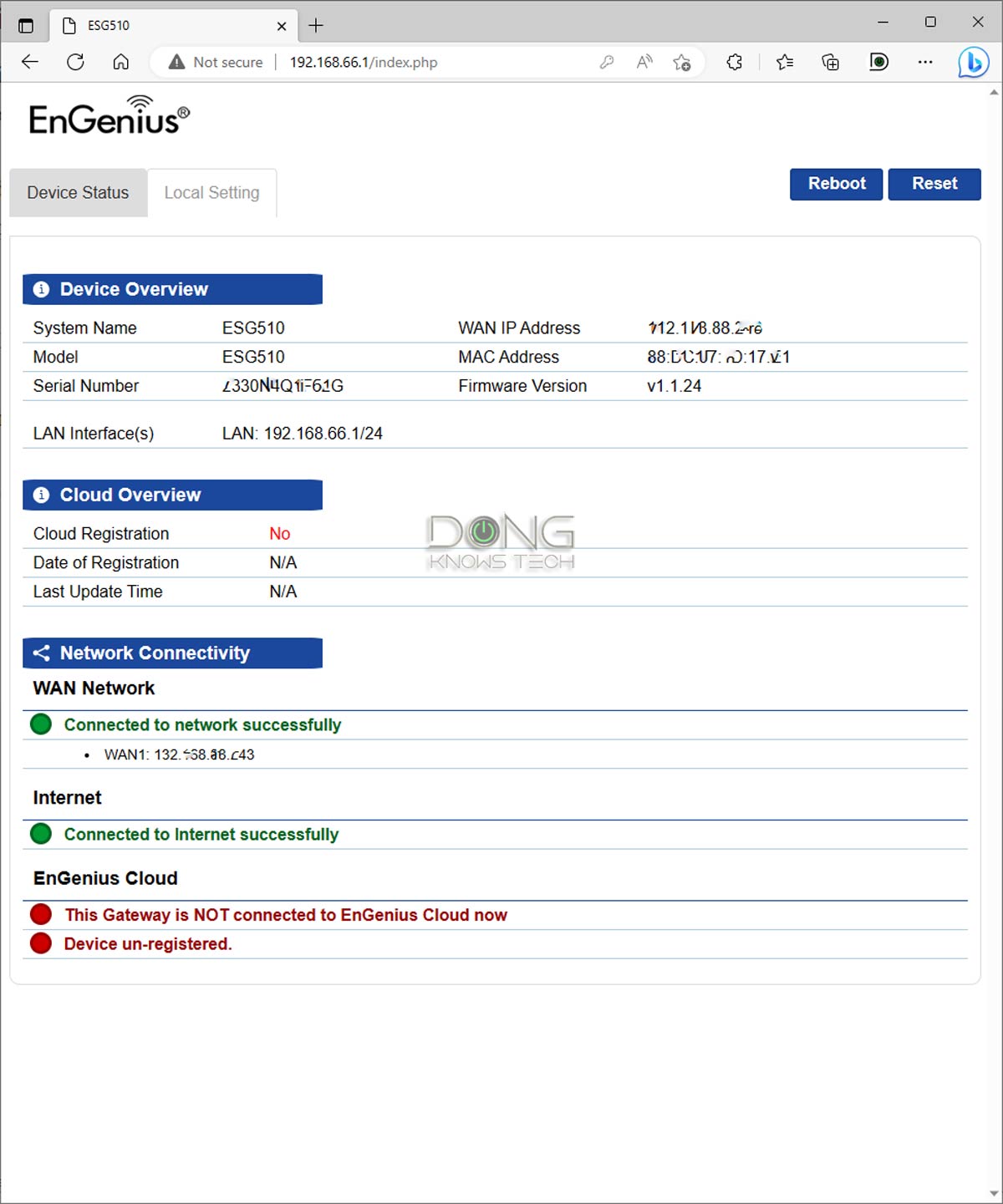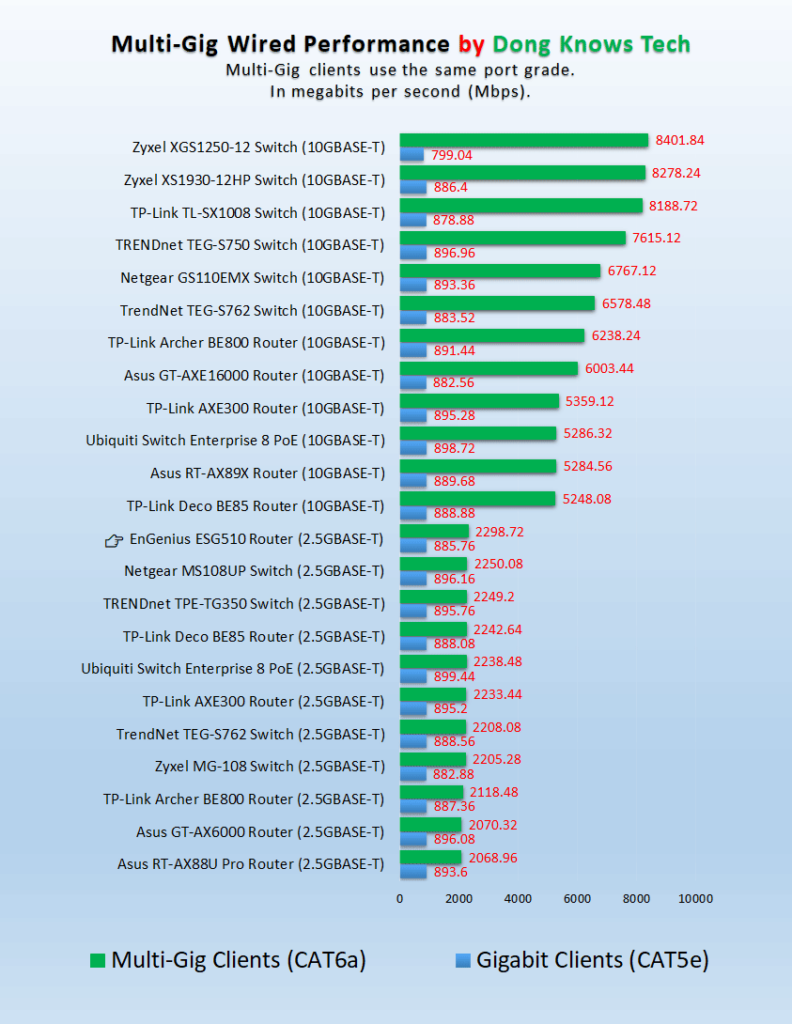Believe it or not, the EnGenius ESG510 is only the second non-Wi-Fi router I’ve reviewed on this website. And like the Firewalla Gold, it’s a niche device designed for savvy/advanced users with a wired environment.
A Wi-Fi router is a standard router with a built-in standard access point in the same hardware box.
The hardware is Wi-Fi-ready, however. It includes a Multi-Gig 2.5GBASE-T PoE+ port best used for a Wi-Fi access point. I’ll emphasize that this router is not for everyone, and at the current street price of $600, it’s not affordable enough for anyone to try it out on a whim.
Here’s the bottom line: For a wired home or office where the Internet drop is not near the center—the case of many homes, unfortunately—the EnGenius ESG510 can be a sensible buy. It has Multi-Gig, security, routing, and VPN in a compact box.
So, if you want to build a serious Wi-Fi network using access points, consider this EnGenius ESG510 today.

EnGenius ESG510: A simple yet sophisticated cloud-managed router
The EnGenius ESG510 is a rectangular box looking like a standard 8-or-fewer-port Multi-Gig switch. And with four Multi-Gig ports, it’s actually similar to a switch.
What makes it decidedly different is that its first port (label WAN1) is the designated default WAN port. Additionally, the second port (WAN2/P3) can work either as a LAN or a second WAN in case of a Dual-WAN setup. After that, the other two are LANs, of which the last one (P1) also supports the PoE+ standard (802.3at).
There’s also a USB port (WWAN) to host an optional backup cellular connection and a legacy console management port which likely will never be used.
The table below shows the EnGenius ESG510’s hardware specifications.
EnGenius ESG510: Hardware specifications
| EnGenius ESG510 Cloud Managed Firewall Router | |
| Processing Power | 1.6GHz Quad-Core CPU, 4GB RAM, 8GB Flash |
| Multi-Gig port | 2x 2.5GBASE-T WAN/LAN 1x 2.5GBASE-T LAN 1x 2.5GBBASE-T PoE+ LAN |
| Gigabit Ports | None |
| Console Port | 1 |
| Max Internet Speed | 2.5Gbps |
| Dual-WAN | Yes (load-balancing or failover) |
| USB Port | 1x WWAN (cellular backup) |
| Routing Features | WAN load balancing with WRR Networking Features Static Route Multiple WANs USB Cellular User Authentication PPPoE VLAN Tagging Captive Portal Custom Splash Page Dynamic Routing Bandwidth Limit Traffic Load Balancing DHCP client/server/relay Dynamic DNS support |
| Firewall Feautres | Stateful Packet Inspection Policy Rules Port Forwarding 1:1 NAT Allow Inbound Services |
| VPN Features | Site-to-Site VPN Client VPN Policy-based VPN IPsec NAT traversal (NAT-T) Dead Peer Detection (DPD) Auto-VPN Connection Auto NAT traversal |
| Dimensions | Width: 8.27″ (210 mm) Length: 7.07″ (179.5 mm) Length: 7.07″ (179.5 mm) Height: 1.38″ (35 mm) |
| Weight | 2.14 lbs (.97 kg) |
| Operating Temperature | 32°F to 104°F (0°C to 40°C) |
| Power Input | 110 – 240 V |
| Power Consumption (per 24 hours) | ≈ 230 Wh |
| Local Web Interface | Yes (limited) |
| Online Portal | Yes (EnGenious login required) |
| Warranty | two years |
| US MSRP | $599 |
Limited local web user interface
The EnGenius ESG510 works right out of the box via its default setting if you only want a simple network. It’s preconfigured as a simple router with default standard settings.
The hardware setup is simple. Here’s how:
Connect the router’s default WAN port (WAN1) to an Internet source, such as a modem or a Fiber-optic ONT. Plug it into power, and mission accomplished!
Now you can add up to three wired devices to the router, one of which can be a PoE device or a switch to host more clients. And that’s all there is to do to get your network up and running.
In this case, the router has a local web user interface accessible via its default IP address, 192.168.66.1, with admin as the default username and password.


Unfortunately, you can’t do much with this interface. There’s no way to change even the simplest settings, such as the router’s DHCP function. All you can do is configure the WAN connection(s) between a few common options—PPoE, Dynamic or static IP, etc.—and upgrade the router’s firmware.
So to make the router worth the hefty cost, you must use it via EnGenius’s Cloud portal, which enables you to customize it to the max.
EnGenius Cloud is a must-use
It’s straightforward to register the EnGenius ESG510 with an EnGenious Cloud account—the same account you’d use if you have other EnGenious Cloud-managed devices, such as the ECW336 access point.
During the testing, I used the ECW336 with the ESG510, and the two worked well together.
All you have to do is create a free account at cloud.engenius.ai, sign in, and enter the router’s serial number in the Inventory & License section.
Alternatively, you can do that via the Cloud-to-Go mobile app, which makes the process as simple as using the phone’s camera to scan the QR code under the router.
After that, restart the router manually—this is a must-do step—and it’ll immediately become available via the web address above.
I had an existing EnGenious Cloud account, and it took me less than 10 minutes to get the router up and running with the ECW336 AP.
EnGenious Cloud has two access levels, Basic vs. Pro. The former is free and generally has what most homes or office needs, whereas the latter requires licensing fees which vary depending on the situation.
No matter which tier you use, EnGenious Cloud offers access to all of the router’s settings and features, which include standard features (such as Dynamic DNS, port-forwarding, VPN), and more.
It’s worth noting, though, that while the functions and settings of the ESG510 are similar to that of most standard routers, its interface is a bit different since it’s made for advanced users. That’s the case with all business hardware. There might be a bit of a learning curve.


Still, the idea behind the Cloud portal is convenience. You can manage multiple devices and even organizations in one place. For example, you can easily use two EnGenius ESG510 units for two locations, link them via VPN (or not), and then manage both in the same account.
In return, your devices are always connected to EnGenius, which incurs inherent privacy risks. Here’s EnGenious’s Privacy Policy.
EnGenius ESG510: Detail photos








EnGenius ESG510: Reliable and fast Multi-Gig performance
I used most of the ESG510’s features and settings applicable for a standalone office (or a home), and all worked as intended. There were no surprises.
Additionally, I tried it with a few PoE access points, including EnGenious’s own ECW336, and they all worked well. The ECW336 was the best option, however, since it’s part of the company’s Cloud-Managed family. The two proved to be excellent pairs, delivering a fast and reliable wired/Wi-Fi network.
If you use an access point or any standard PoE device (of the PoE+ standard or lower) from a different vendor, you’ll have to manage it separately. But it’ll work with the router’s PoE port.
The ECW336 access point’s Wi-Fi performance was the same when I used it with other routers via a PoE switch or injector. I reviewed it separately here.

Over more than a week of real-world usage, I ran into no issue with the router. The hardware remained cool, by the way, and seemed to have no internal fan—it was completely silent.
In terms of throughput, as a 2.5GBASE-T device, the EnGenius ESG510 had the fastest sustained rates compared with all routers and switches of the same grade—the first I’ve seen. All other Multi-Gig routers I’ve tested sustained slower than switches of the same speed grade.
EnGenius ESG510's Rating

Pros
Simple and straightforward to set up and use
Four Mult-Gig ports with Dual-WAN, PoE+ support
EnGenious Cloud Basic (free) has everything a home or SMB network needs with a helpful Cloud-to-Go mobile app
Compact, practical design; runs cool
Cons
A bit pricey; zero customization with the built-in local web interface
The online portal requires a login account; no 10GBASE-T or SFP+ option
Requires some networking know-how to set up and manage
Conclusion
Again, the EnGenius ESG510 is not a router for everyone. However, it’ll make an excellent buy if you:
- are looking for a non-Wi-Fi router,
- don’t mind the required online account,
- consider yourself an advanced user, and
- want to build a Multi-Gig wired or Wi-Fi network via switches or PoE access points.
It’s a big if, and that’s the point. This is a niche piece of hardware that, when applicable, will work out great. Evaluate your situation and maybe consider one today.



Thank you for this great resource! We have a structured panel for whole home internet/tel distribution. Out Leviton router and switch are dying and I need new pieces. However I am having trouble finding suitably priced and sized replacements. Both are gigabit. Do you have any recommendations that are small enough and as noted priced for home use? The ESG510 looks maybe right but we need 5 ports on the router and 5 on the switch. Thoughts?
You can get any router and an additional switch, Josh. But if you want just one piece of hardware the Asus RT-AX88U Pro is a good fit. It can also host a mesh system via AiMesh and you have lots of options. Give the review a good read and follow the related posts for more.
Thank you. I think that would be great but too big to be able to fit in the panel and not enough ports. I’ll keep searching!
I actually meant the original RT-AX88U. Sorry about that. That’s the only router of Wi-Fi 6 standard (or later) I know with that many of ports. But generally if you need lots of ports, a switch is in order. Gigabit switches are very affordable these days.
hello Dong, thanks for your great work! Searched for some reviews of avm’s fritz! routers. could i ask why never review any of them?
thanks again
The Fitz brand is generally ony available in EU and not in the US, Marco. And I only have acces to stuff available in the US.
But, in my personal expereince, Fritz is quite good.
Hi Dong, great article. Would you consider writing about Opnsense router setups in this light?
I’m open to it, Kevin. But it’s always a matter of time and resources.